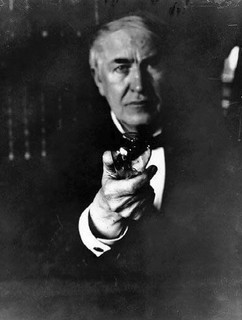 Thomas Edison was a great inventor. But Thomas Edison was a greater salesperson. He and his team may have invented the electric light bulb, but without the support and resources (read investment) of others, that idea wouldn’t have moved forward from his team. The idea looks obvious now, but all successful new ideas look good with the 20/20 perspective of looking backwards.
Thomas Edison was a great inventor. But Thomas Edison was a greater salesperson. He and his team may have invented the electric light bulb, but without the support and resources (read investment) of others, that idea wouldn’t have moved forward from his team. The idea looks obvious now, but all successful new ideas look good with the 20/20 perspective of looking backwards.
Much of the writing and thinking about creativity is about getting the idea. While getting the idea is a necessary seed for the process, in the end you must be successful in convincing, persuading and yes, selling your creative ideas if you want them to be used and applied.
The time will come, sooner or later, when you have a great, new idea that you want to persuade others to support, provide resources for or buy. If you don’t sell it, it is almost like you never had the idea in the first place.
Here are some suggestions on how to help others see what you already see – and sell them on your creative idea.
- Start by understanding their perspective. You already understand and are excited by your idea and its prospects. Remember that they aren’t there yet mentally (that is why you are having a conversation with them). Don’t make a presentation, have a conversation. And don’t make it about your idea, but about them and their needs. Understand what their perspective is first and craft your whole plan based on them and their needs.
- Connect your idea to pain they experience. You are likely enamored by the benefits of your idea. Others care less about that than about reducing the pain, frustration, and challenges they face. Know what their pain is, then help them see how your idea will alleviate that pain.
- Tell a story. Stories are a powerful communication tool. But don’t make it about you and your idea (or how you came up with the idea). Make them the star of your story – and how your idea solves their problems and makes their life better.
- Show them the end result. Help people see the idea in action and what it will do in the world. Once you have identified and alleviated pain, now you can talk bigger picture benefits of how the world is different because of your idea. We think in pictures so if you help people see the outcome in a vivid three-dimensional picture, your message will be more compelling.
- Be enthusiastic. Be sold on the idea yourself. If not, you have already lost. Think about it – are you drawn to people who have a genuine passion and belief in what they are talking about? (So will the people you are trying to persuade.) You can’t use your attitude and passion alone – it must be connected to the other items on this list – but without it, you will be far less successful.
- Be patient. Give people time. The minute you share your creative idea people may not immediately jump up and say “let’s do it!” Be patient both in the moment and as people have time to think about it.
- Be Persistent. Patience is important but patience with persistence is more effective. Follow-up with people as they have time to think about your idea. Ask them follow-up questions to better understand their concerns and to further clarify your vision. If your idea is worth the effort, make the effort.

Thanks Kevin,
A very timely reminder of what to keep in mind as I have a meeting with a client about a new idea this morning. I liked the reminders that its not all about the idea – i.e. without the support of others an idea is just an idea, and that its not all about me and my idea. All too easy to get caught up in what I’m excited about and miss the bigger picture.